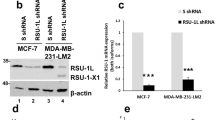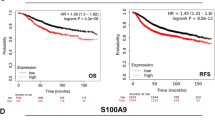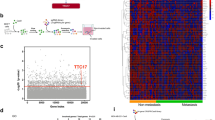Abstract
Metastasis, responsible for most deaths from breast cancer (BC), is a multistep process leading to cancer cell spread. Extracellular matrix (ECM)-related adhesion and apoptosis resistance play pivotal role in metastasis. Ras suppressor-1 (RSU-1) localizes to cell-ECM adhesions and binds to pro-survival adhesion protein PINCH-1. Little is known about the role of RSU-1 in BC. In the present study, we investigated the role of RSU-1 in BC metastasis using two BC cell lines that differ in terms of their metastatic potential and a set of 32 human BC samples from patients with or without lymph node metastasis. We show that RSU-1 is upregulated in the aggressive MDA-MB-231 cells compared to MCF-7 and that its silencing by siRNA leads to upregulation of PINCH-1, induction of proliferation and reduction of apoptosis through downregulation of the pro-apoptotic gene p53-upregulated-modulator-of-apoptosis (PUMA). Our findings in the cell lines were further validated in the human BC tissues where normal adjacent tissues were used as controls. We demonstrate for the first time, that RSU-1 expression is upregulated in metastatic BC samples and downregulated in non-metastatic while it is negatively correlated with PINCH-1 and positively correlated with PUMA expression, suggesting that a pro-apoptotic mechanism is in place in metastatic BC samples and identifying RSU-1 as a potentially interesting molecule that needs to be evaluated further as a novel BC metastasis biomarker.




Similar content being viewed by others
Abbreviations
- BC:
-
Breast cancer
- BMI:
-
Body mass index
- ECM:
-
Extracellular matrix
- ER:
-
Estrogen receptor
- PINCH-1:
-
Particularly interesting new cysteine-histidine-rich protein-1
- PBGD:
-
Porphobilinogen deaminase
- PR:
-
Progesterone receptor
- PUMA:
-
p53-upregulated-modulator of apoptosis
- RSU-1:
-
Ras suppressor-1
- UHL:
-
University Hospital of Larissa
References
Weigelt B, Peterse JL, van ‘t Veer LJ (2005) Breast cancer metastasis: markers and models. Nat Rev Cancer 5:591–602
Kakonen SM, Mundy GR (2003) Mechanisms of osteolytic bone metastases in breast carcinoma. Cancer 97:834–839
Hynes RO (2002) Integrins: bidirectional, allosteric signaling machines. Cell 110:673–687
Ungefroren H, Sebens S, Seidl D, Lehnert H, Hass R (2011) Interaction of tumor cells with the microenvironment. Cell Commun Signal 9:18
Wang Y, Simpson JA, Wluka AE, Teichtahl AJ, English DR, Giles GG, Graves S, Cicuttini FM (2009) Relationship between body adiposity measures and risk of primary knee and hip replacement for osteoarthritis: a prospective cohort study. Arthritis Res Ther 11:R31
Valastyan S, Weinberg RA (2011) Tumor metastasis: molecular insights and evolving paradigms. Cell 147:275–292
Mehlen P, Puisieux A (2006) Metastasis: a question of life or death. Nat Rev Cancer 6:449–458
Rennebeck G, Martelli M, Kyprianou N (2005) Anoikis and survival connections in the tumor microenvironment: is there a role in prostate cancer metastasis? Cancer Res 65:11230–11235
Cutler ML, Bassin RH, Zanoni L, Talbot N (1992) Isolation of rsp-1, a novel cDNA capable of suppressing v-Ras transformation. Mol Cell Biol 12:3750–3756
Dougherty GW, Chopp T, Qi SM, Cutler ML (2005) The Ras suppressor Rsu-1 binds to the LIM 5 domain of the adaptor protein PINCH1 and participates in adhesion-related functions. Exp Cell Res 306:168–179
Kadrmas JL, Smith MA, Clark KA, Pronovost SM, Muster N, Yates JR 3rd, Yates JR 3rd, Beckerle NC (2004) The integrin effector PINCH regulates JNK activity and epithelial migration in concert with Ras suppressor 1. J Cell Biol 167:1019–1024
Chen K, Tu Y, Zhang Y, Blair HC, Zhang L, Wu C (2008) PINCH-1 regulates the ERK-Bim pathway and contributes to apoptosis resistance in cancer cells. J Biol Chem 283:2508–2517
Xu Z, Fukuda T, Li Y, Zha X, Qin J, Wu C (2005) Molecular dissection of PINCH-1 reveals a mechanism of coupling and uncoupling of cell shape modulation and survival. J Biol Chem 280:27631–27637
Dougherty GW, Jose C, Gimona M, Cutler ML (2008) The Rsu-1-PINCH1-ILK complex is regulated by Ras activation in tumor cells. Eur J Cell Biol 87:721–734
Vasaturo F, Dougherty GW, Cutler ML (2000) Ectopic expression of Rsu-1 results in elevation of p21CIP and inhibits anchorage-independent growth of MCF7 breast cancer cells. Breast Cancer Res Treat 61:69–78
Al-Nasiry S, Geusens N, Hanssens M, Luyten C, Pijnenborg R (2007) The use of Alamar Blue assay for quantitative analysis of viability, migration and invasion of choriocarcinoma cells. Hum Reprod 22:1304–1309
Riccardi C, Nicoletti I (2006) Analysis of apoptosis by propidium iodide staining and flow cytometry. Nat Protoc 1:1458–1461
Antony ML, Kim SH, Singh SV (2012) Critical role of p53 upregulated modulator of apoptosis in benzyl isothiocyanate-induced apoptotic cell death. PLoS One 7:e32267
Acknowledgments
This study was supported in part by Optimum Orthopedics S.A. which had no role in the design, execution or interpretation of the study.
Conflict of interest
The authors declare that they have no conflict of interest.
Author information
Authors and Affiliations
Corresponding author
Additional information
Nikolina Giotopoulou and Vaia Valiakou have contributed equally to this work.
Rights and permissions
About this article
Cite this article
Giotopoulou, N., Valiakou, V., Papanikolaou, V. et al. Ras suppressor-1 promotes apoptosis in breast cancer cells by inhibiting PINCH-1 and activating p53-upregulated-modulator of apoptosis (PUMA); verification from metastatic breast cancer human samples. Clin Exp Metastasis 32, 255–265 (2015). https://doi.org/10.1007/s10585-015-9701-x
Received:
Accepted:
Published:
Issue Date:
DOI: https://doi.org/10.1007/s10585-015-9701-x




